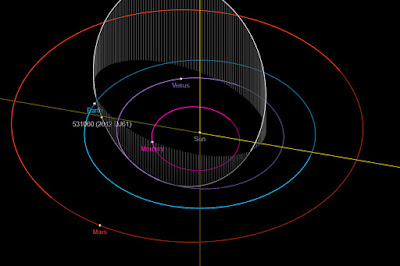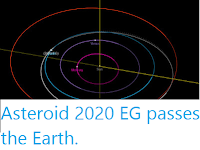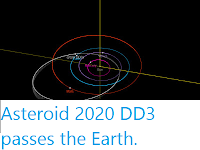Asteroid (531060) 2012 DJ61 passed by the Earth at a distance of about 12 192 000
km (31.7 times the average distance between the Earth and the Moon, or 8.15% of the distance between the Earth and the Sun), slightly after 3.00 am
GMT on Thursday 5 March 2020. There was no danger of
the asteroid hitting us, though were it to do so it would have
presented a considerable threat. (531060) 2012 DJ61 has an estimated
equivalent
diameter of 200-620 m (i.e. it is estimated that a spherical object with
the same volume would be 200-620 m in diameter), and an object of this
size would be predicted to be capable of passing through the Earth's
atmosphere relatively intact, impacting the ground directly with an
explosion that would be 15 000-600 000 times as powerful as the
Hiroshima
bomb. Such an impact would result in an impact crater 3-8 km in
diameter
and devastation on a global scale, as well as climatic effects that
would last decades or even centuries.
The calculated orbit of (531060) 2012 DJ61. Minor Planet Center.
(531060) 2012 DJ61 was discovered on 28 February 2012 by the University of Hawaii's PANSTARRS telescope. The
designation 2012 DJ61 implies that it was the 1534th asteroid (asteroid J61 -
in numbering asteroids the letters A-Y, excluding I, are assigned
numbers from 1 to 24, with a number added to the end each time the
alphabet is ended, so that A = 1, A1 = 25, A2 = 49, etc., which means that J61 = 6 + (24 X 61) = 1534)
discovered in the second half of February 2012 (period 2012 D), while
the designation 531060 implies that it was 531 060th asteroid ever
discovered (asteroids are not given this longer designation immediately
to avoid naming double or false sightings).
(531060) 2012 DJ61 has a 321 day orbital period, with an elliptical orbit tilted at
an angle of 53.6° to the plain of the Solar System which takes in to
0.44 AU from the Sun (44% of the distance at which the Earth orbits the
Sun, and slightly more than the distance at which Mercury orbits the Sun) and out to
1.39 AU (39%
further away from the Sun than the Earth). This means that close
encounters between the asteroid and Earth are fairly common, with the
last thought to have happened in February 2013 and the next predicted
in March 2027. Although it does cross the Earth's
orbit and is briefly
further from the Sun on each cycle, (531060) 2012 DJ61 spends most of its time
closer to the Sun than we are, and is therefore classified as an Aten
Group Asteroid. As an asteroid probably larger than 150 m in diameter
that occasionally comes within 0.05 AU of the Earth, (531060) 2012 DJ61 is also
classified as a Potentially Hazardous Asteroid. The asteroid also has occasional close encounters with the planet Mercury, with the last having happened in November 1965, and the next predicted for February 1951.
See also...
Follow Sciency Thoughts on Facebook.







